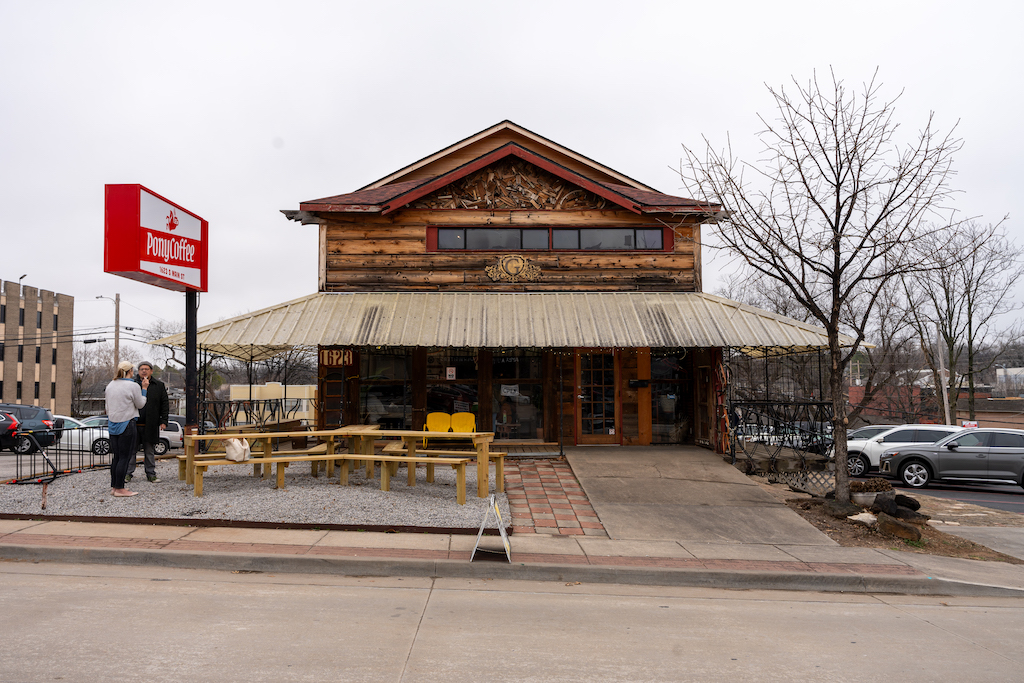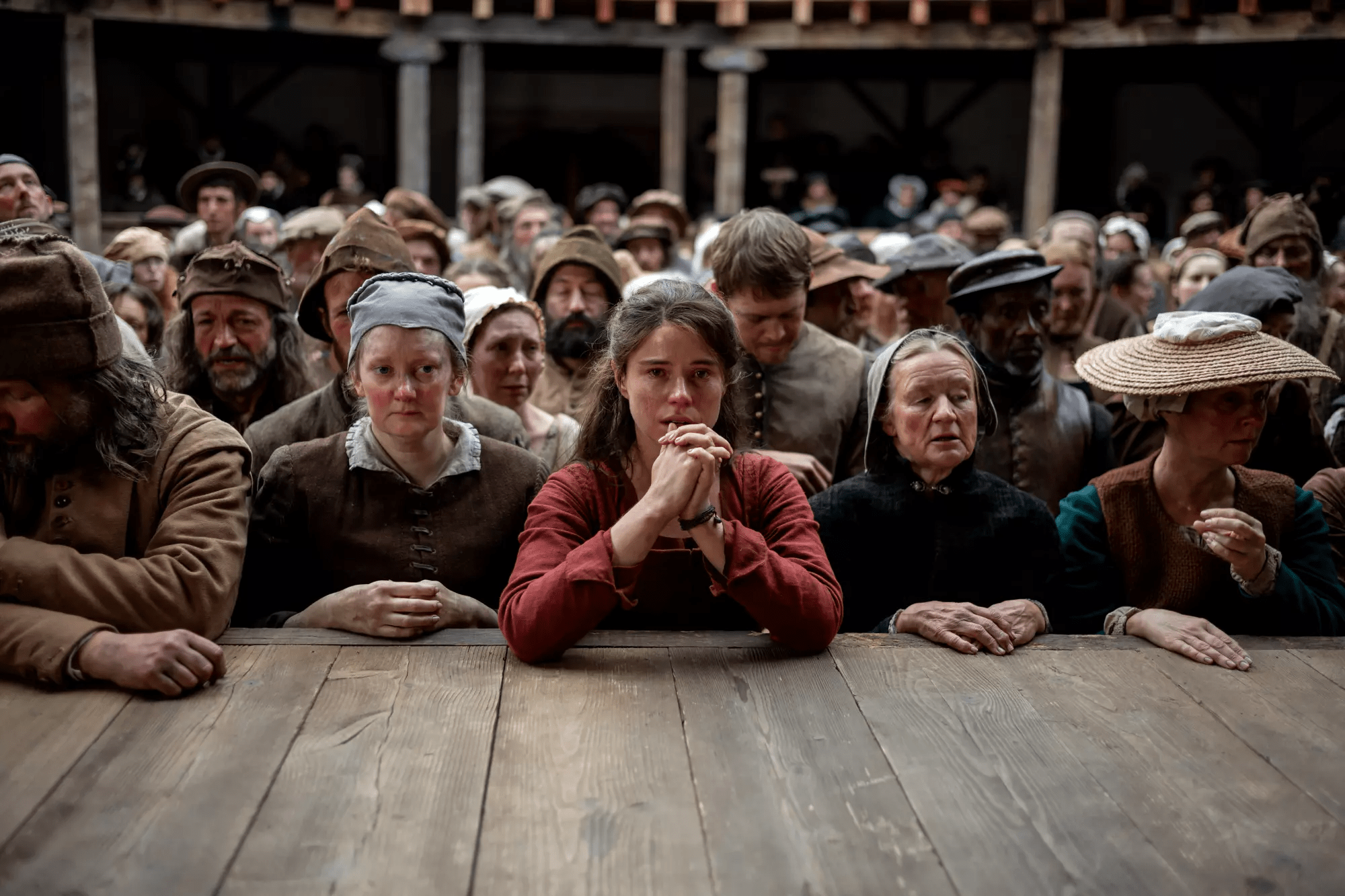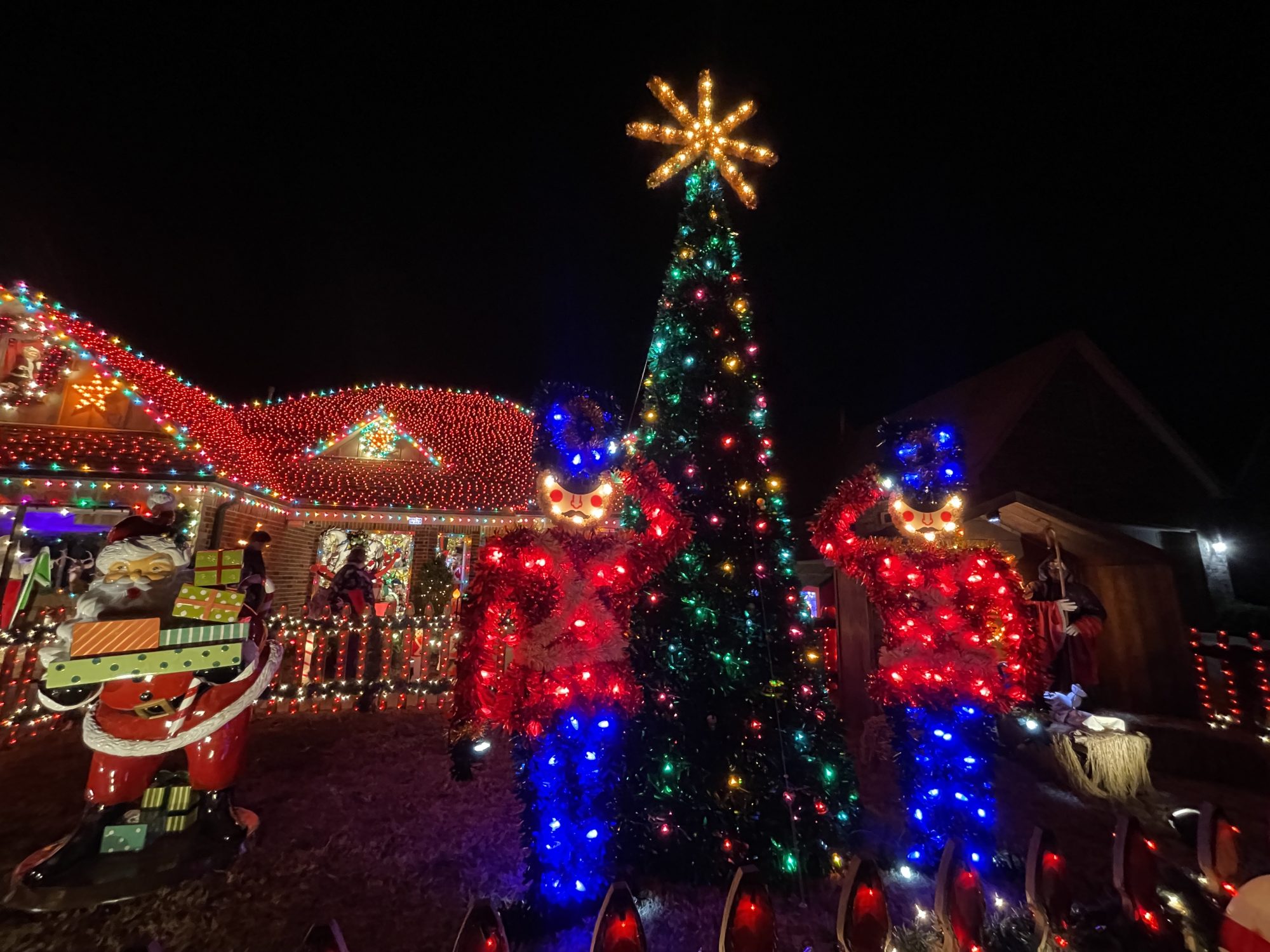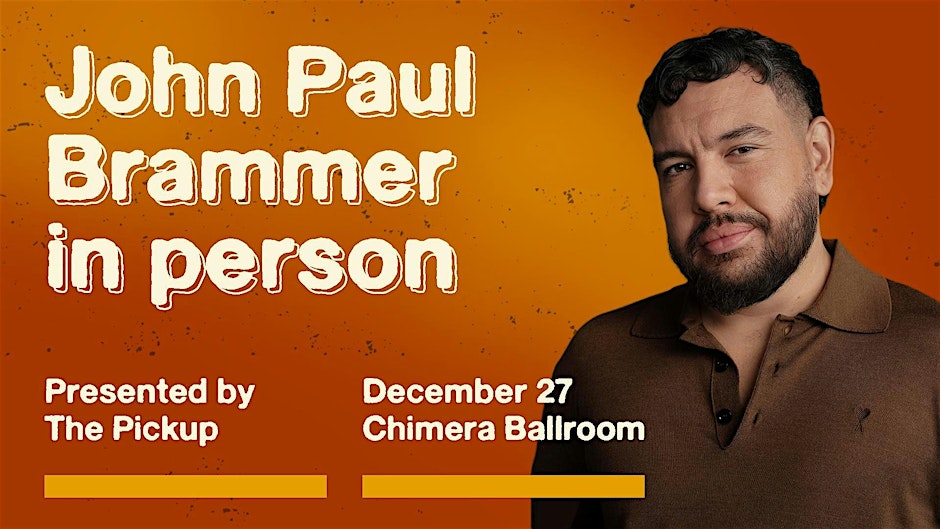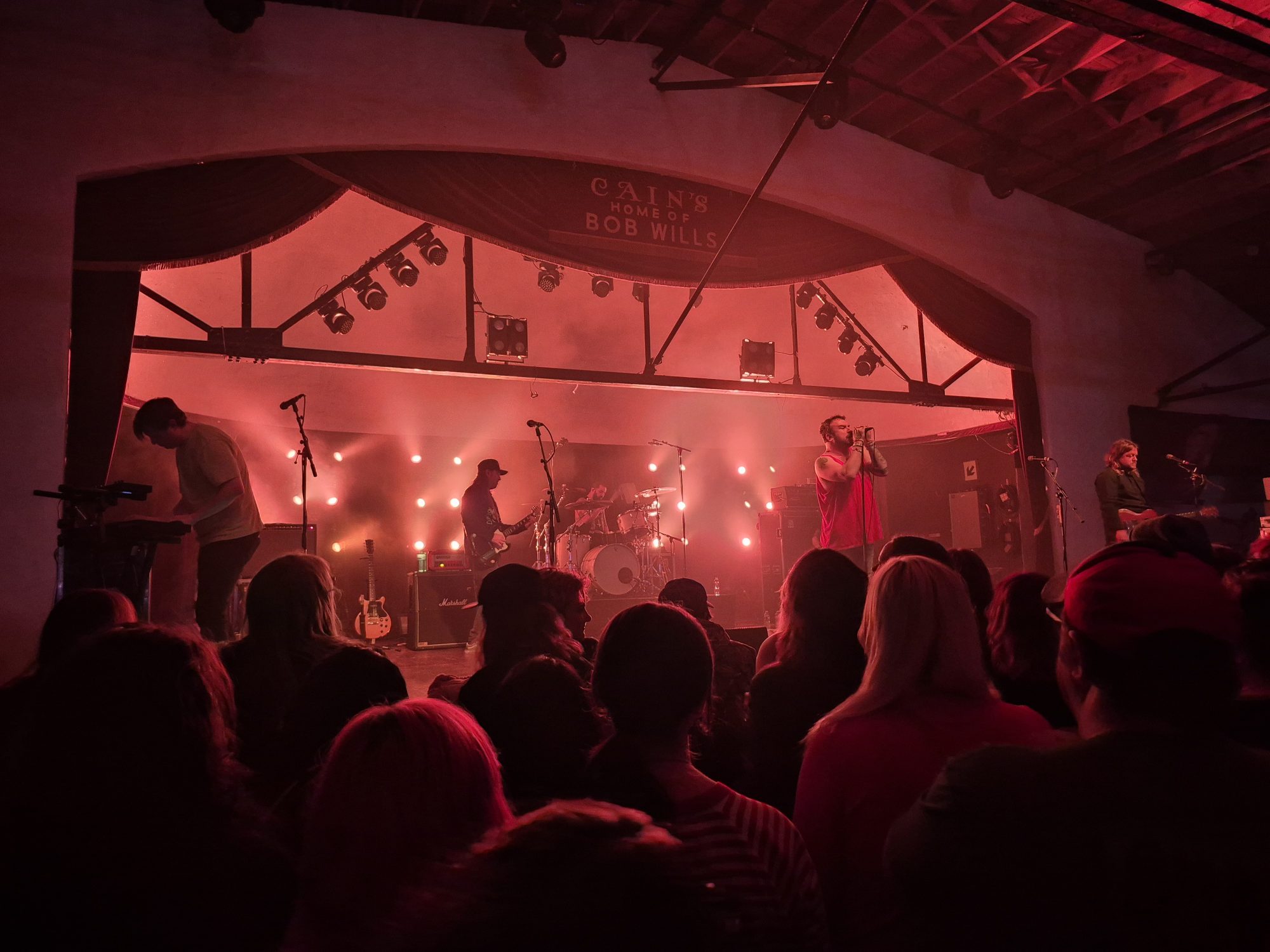Editor's note: Pony Coffee wouldn't be what it is without Gaylord Oscar Herron. In a 2012 This Land piece called "The Genesis of Vagabond," Grant McClintock told the story behind Herron's photographic masterpiece, Vagabond, linking through to the downtown bike shop—G. Oscar Bicycles—that's now become a quintessentially Tulsa hang.
It’s a Saturday morning and I’m standing on the second floor of a downtown house, dizzy with deja vu. It’s not quite the feeling that I’ve been here before, though I have. It’s more like I’m looking through a stack of negatives held together against the light, seeing the same spot through multiple frames, the texture of one image filtering through the outline of another.
Right now, in 2025, it seems like all of Tulsa is sitting inside this house, chatting, working. Moms and musicians and millennial remoters are tucked into odd corners, and a couple of kids are playing drums out back, all watched over by a plastic toy horse, an APPLAUSE sign, a kaleidoscope of bike wheels, and ephemera about a man named Gaylord Oscar Herron. Stickers peel off the walls; scuff marks streak the creaking floors. Since Pony Coffee opened here back in October, it’s become SoBo’s new favorite place for caffeinated public privacy. It’s small enough to feel cozy, big enough so you can find a seat without too much trouble. It’s a house you’d gladly leave the house to go hang out in.
The last time I came here, it was Gaylord Oscar Herron himself I was looking for. It was 2017, and the spot was called G. Oscar Bicycles then, but I wasn’t there for a bike. Herron—the visionary photographer of the 1975 photo essay Vagabond—wasn’t there strictly for bikes either, though he had a long history with them by then: as a kid working on mechanical stuff with his father; as someone whose eye was drawn to them as a young photographer, as he told The Tulsa Voice; and as this shop’s longtime proprietor. The bike shop had become, Herron said, “how I maintain my contact with people.”
I came to G. Oscar’s to interview Herron about a group photography show called “Home,” in which some of his work was going to appear. I found him surrounded by the chaos of tools and tubes and wheels that had built up around him since he’d moved his bike business (originally located at what’s now Grumpy’s Garden) into this house two decades earlier.
We spoke downstairs for a while, and then, focused and soft-spoken, he led me up the zigzag steps onto the second floor, where the world of bikes gave way to the world of his photography. He showed me his Tulsa, spread out across tables in piles of loose unpublished prints and crumbling albums: a city of glimmers and shadows in sepia and gray, a city of what he called “dappled light.” When I walked back down and out the door, the street outside looked different, vibrating with the after-images of what he’d shown me.
“Herron’s work unveils the unseen,” Grant McClintock wrote in This Land, “not just what we observe but how what we observe works on us—not just the world as it appears but what it feels like underneath.”
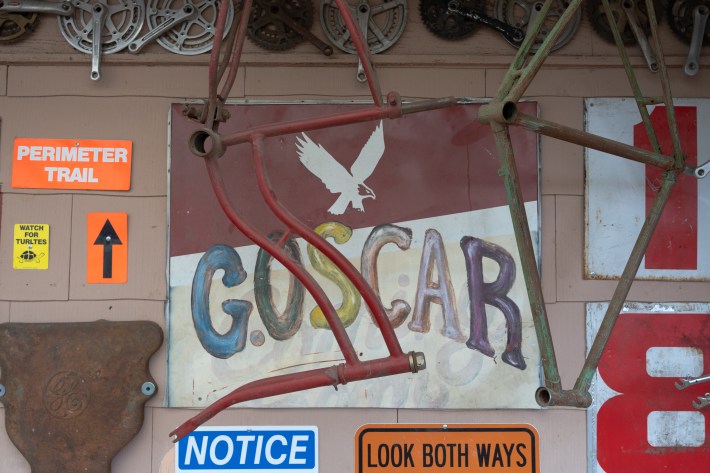
Today, the place where one of those tables stood is occupied by a pair of chatting friends. I’m close by, sitting on a bright, frosty morning with Shane Hood (who serves on the Tulsa Metro Planning Commission and the Tulsa Preservation Commission, and has a long list of local preservation credits to his name) and Jason Gibson, both of Align Design, the Tulsa firm that served as architect for Pony Coffee. Hood is looking out the window at the Vogue Apartments across the parking lot to the north, telling me stories he dug up from old newspaper clippings and articles while working on the project.
In the mid-1960s, one story goes, Herron had just come back to Oklahoma after working (and going broke) as a photographer’s assistant in New York. He found a place to live in those very Vogue Apartments and, one day, having heard that the photographer Bob Hawks had a studio in the house next door—this very house—he walked over to see about a job.
“You know what’s crazy about that?” Gibson says. “The first day Pony Coffee was open, I was in here about 8 o'clock in the morning and someone walked out of those apartments and came in here and was like, ‘Are you guys hiring?’”
***
The story of 1623 S. Main goes back to 1916. “I found this ad for the original real estate company that was selling this house,” Hood tells me. The home had six bedrooms and two sleeping porches. The living room featured a fireplace, built-in bookcases, a writing desk, and china cabinets. “Have garage and living quarters for servants,” the ad notes; “shade trees; peach trees in rear.”
The house was broken up into apartments, he says, probably just over a decade later. “There were seven rooms for rent, and you could rent a room for 60 bucks a month or something like that. And you start to get these newspaper listings for all these people who are moving in”—folks traveling through Tulsa in the ‘30s and ‘40s, renting for a time and moving on. In 1947, the Tulsa Tribune reported that a 16-year-old boy who lived here was one of two Central High School students who claimed to have seen a UFO flying around downtown.
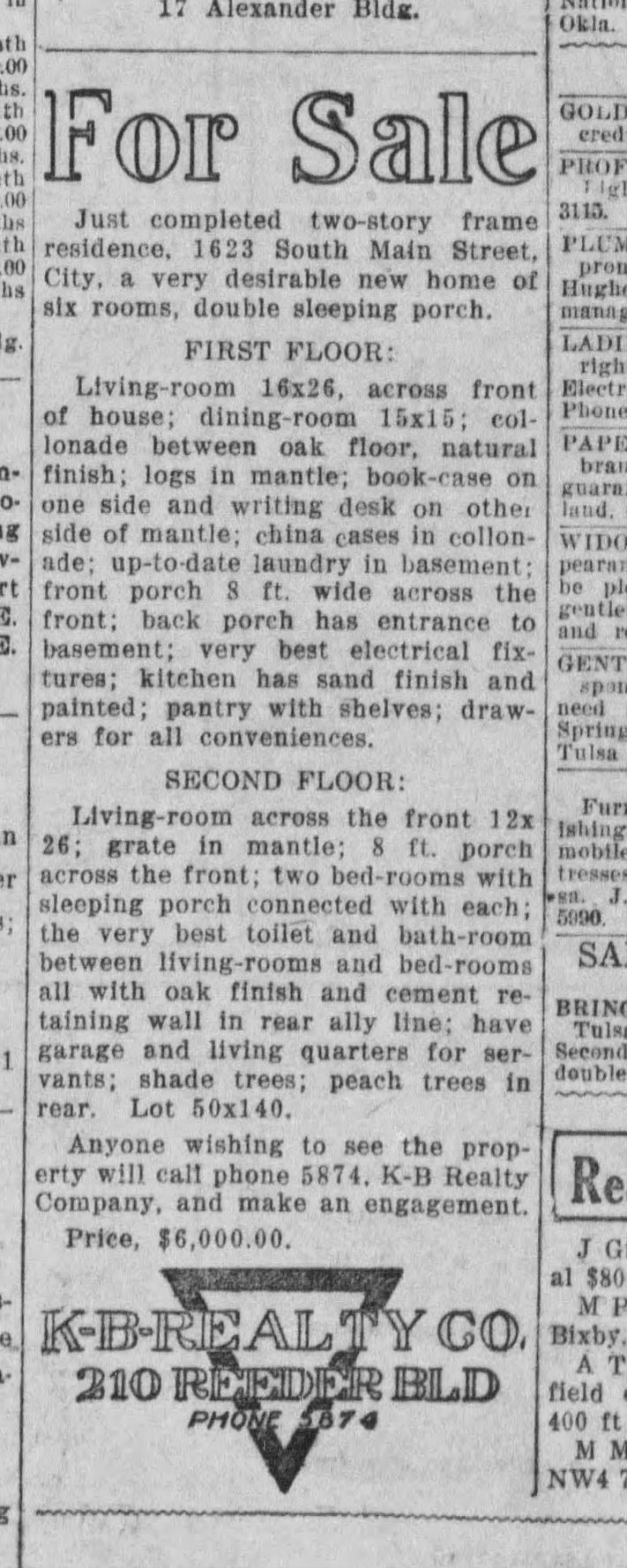
Enter Bob Hawks, who moved his new photography business to this house in 1950. In “The Genesis of Vagabond,” McClintock describes Hawks as “a tree-shaking money-maker,” and the space quickly became a hub for photographers and creative people of mid-century Tulsa. The Hawks-Terrell studio (which did architectural and industrial photography, including significant documentation of Lortondale) operated out of here. The painter and illustrator Bettina Steinke Blair and her husband Don—who are a whole story of their own—had artist studios on the second floor in the early 1950s before moving to Taos. The Blairs were gone by the time Herron walked in looking for work, but it remained a bustling place. “There were other photographers here, too,” Hood says. “Their names weren't on the doorstep, but they were probably having little shows and that kind of stuff. So there was a community. It was a center for art. It was a location for progressive ideas and discussions.”

After Hawks moved his business to Cherry Street in 1967—by which time Herron was working for the Tribune—1623 S. Main kept serving as a photography studio. Tulsa County Assessor’s records show that in 1995 ownership of the property transferred to Douglas Grandstaff, a retired Tulsa Fire Department district chief who was also a photographer. Two years later, Gaylord Herron re-entered the picture. He acquired the space where he’d gotten his first job taking photos in Tulsa, and G. Oscar Bicycles on Main was born.
***
“I love the people who come into the bike shop,” Herron told Roman Candle Magazine in 2021. Its front door was, from 1998 until his death in 2022, his portal to the world. Inside, up those stairs, was a portal to his own.
All of Tulsa can step through those portals now. Whether or not Pony Coffee’s customers know any of these stories, they’re here. The “lived in” feeling that people appreciate about this spot—“the grunge and history and patina,” in Hood’s words—is the result of an intentional and loving preservation.
The house could easily have been scraped, the lot rented out for parking, sold to a chain, rebuilt as a suburban cracker box—the very possibilities that grieved Herron as he watched Tulsa change through the decades. Where another developer might have knocked the place flat or stripped it for a Joanna Gaines-style remodel, Elliot Nelson saw an opportunity to try an experiment in sustainable development, another in his line of such efforts, from McNellie’s to Maple Ridge Grocer. Nelson tipped off his frequent building collaborator Micky Payne that the property was for sale. “He knows what I do,” Payne says, meaning Nelson knew he wouldn’t just come in and bulldoze it. Early in 2024 Nelson, Payne, Josh Gifford, and Chad Potter bought the property together. Gifford and Payne own Soundpony, downtown’s cycling-themed dive bar; the two of them, along with shop manager Clay Welch, are now also Pony Coffee’s owners.
This is a group of community builders with a grunge, history, and patina of their own. Nelson is, of course, the man behind McNellie’s Group. Potter is known locally for preservation projects like Station 13 and The Pump. Welch is a longtime force in music here, familiar to coffee lovers from his many years at Shades of Brown. The Soundpony family tree is a Tulsa wonder; we have it to thank for fostering the likes of the Oilhouse hip-hop collective, Cry Baby Hill, and an afterschool enrichment program called Bike Club. And Payne himself—general contractor for the Pony Coffee project—has been behind the scenes on too many Tulsa build-outs to count, from the Majestic and Soundpony itself, to the old Bowery lounge (now The Tavern), to the Cain’s Ballroom remodel, to his transformation of old buildings in downtown and west Tulsa into affordable live/work spaces for artists through his business Tulsa Art Studios.
“You could not have better people involved in the project to ensure that something like this would happen, with the Tulsa-centric pride they have,” Hood says. “I think the guys on this team all understood from the beginning that this is an important place. Not even so much the building, as what it has been infused with.”
”A lot of the people who come into Pony Coffee have never even heard of Soundpony,” Payne tells me. And although he knew about Herron and the space’s history as a place for artists, he’d come into G. Oscar Bicycles only a couple of times, to buy tubes. This space isn’t a shrine to any of those things, but it does carry their imprint. The real throughline between these businesses is less about bikes or photography or cool hangouts, and more about a Tulsa-specific way with community and sustainability. “As architects, sustainability on our end isn't just about how green our materials are,” says Gibson. “What does sustainability mean for spaces, for culture, for places, for people and society?”
Payne—who does cross country and enduro racing, drives a sports car with a license plate that says “RESIST,” and used to play in a band called Fuzz—puts the idea in his own words: “This place was the perfect storm. Because you can’t buy soul, man.”
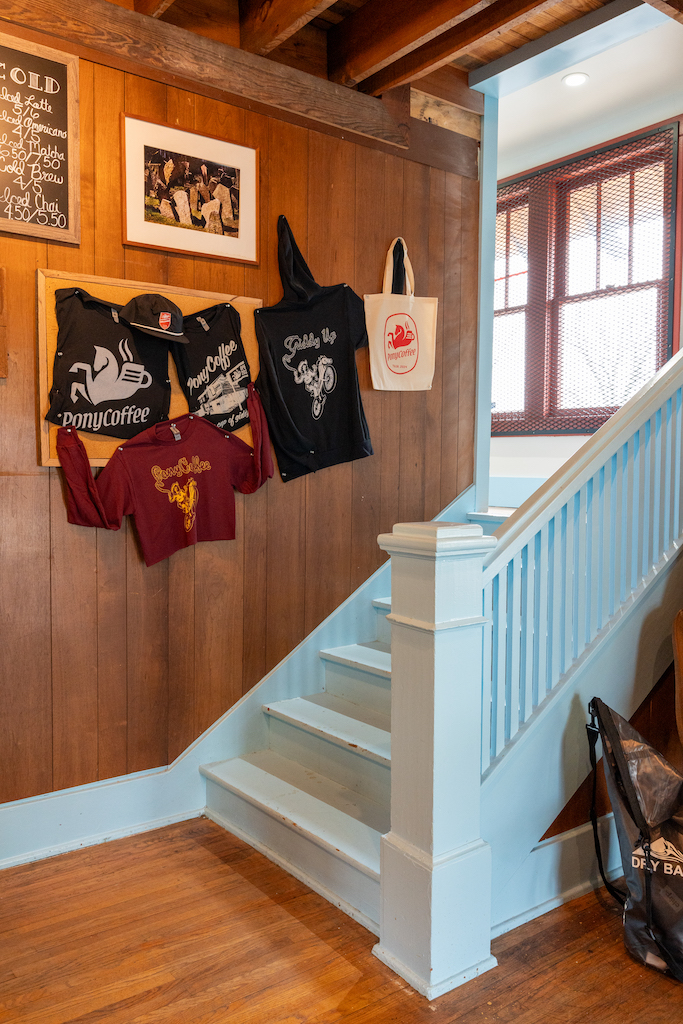
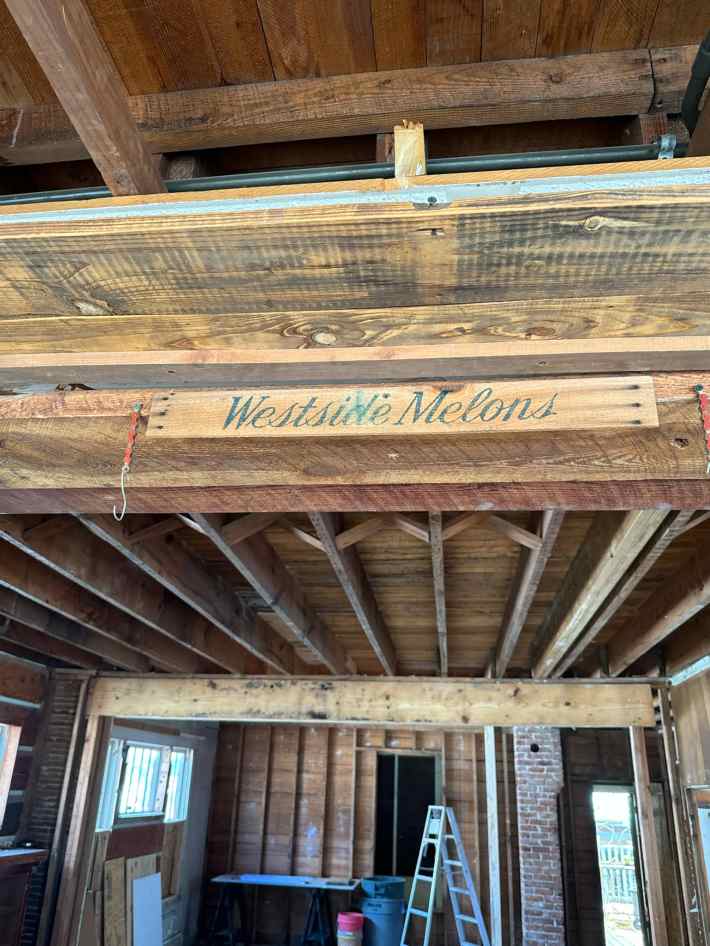
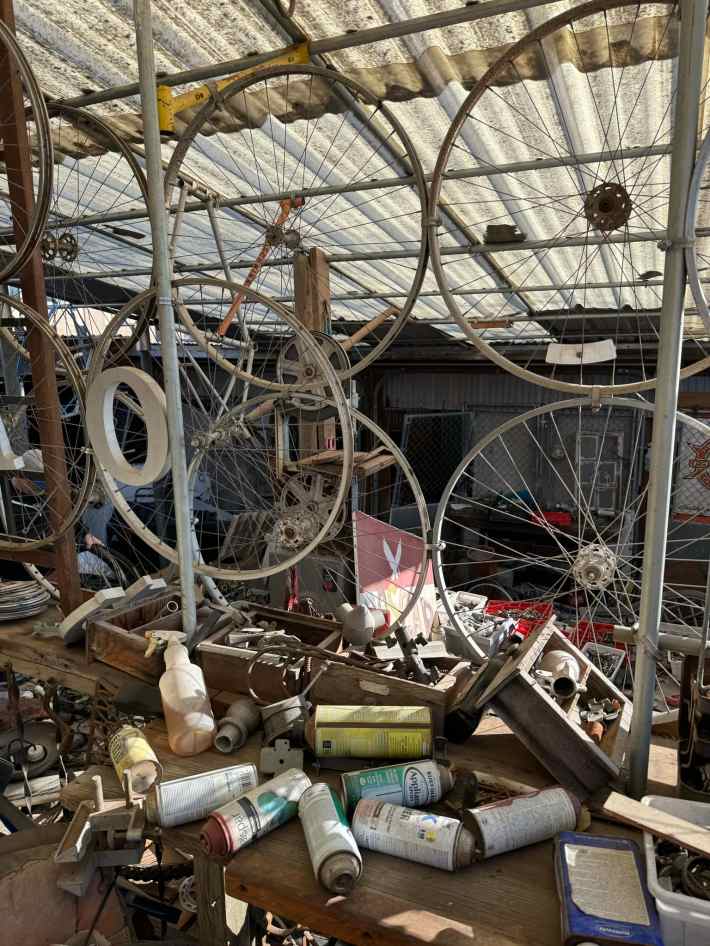
The build-out started in February 2024, with Payne pulling six or seven dumpsters worth of stuff—including probably a thousand bicycles and a thousand wheels, he estimates—out of the house and into his own storage for cataloging. “I had 1,200 square feet of just [Herron’s] stuff. It was like grandma’s house on fleek,” Payne says. He held a community sale to move some of it, but he brought a lot of what he rescued back into the coffee shop, curated with things he’s collected himself through the years—that APPLAUSE sign, for instance, and the big tiles outside the bathrooms, which he’d saved from the ceiling of the old Daddy Dee’s Beehive Lounge in Kendall Whittier.
He walks me through the first floor and the back patio, pointing at something every few seconds. “There's still things that are here from the original, like that little tag, all these stickers up here. Everything is cool. Look at this workbench. This is just stuff [Herron] scabbed together. All these wheels. These are all bike frames that he cut up. Those are garage door tracks; I screwed those up. That's the inside of a piano or an organ or something.” Between the stickers and license plates and other odds and ends on the first-floor walls, you’ll find clippings about Herron and his work. Copies of his photographs hang in the bathrooms in handmade frames.
Upstairs, every turn around a corner reveals a frame of Tulsa’s lesser known history. An original lath and plaster wall stands exposed at the top of the steps. Payne made an end table out of a vintage sewing machine that was already here. The polished bar in the little offset former kitchen came from the downtown Continental Club. Set into the brick above it are copper photography plates of shots from old Central High School yearbooks, which the design team saved from Herron’s space and tiled into the wall.

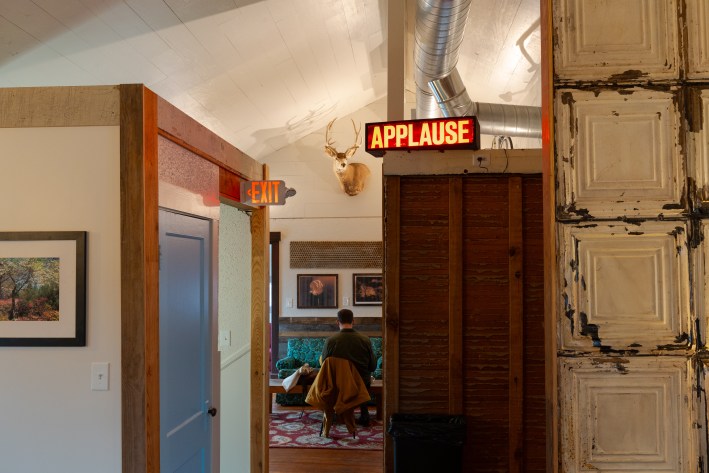
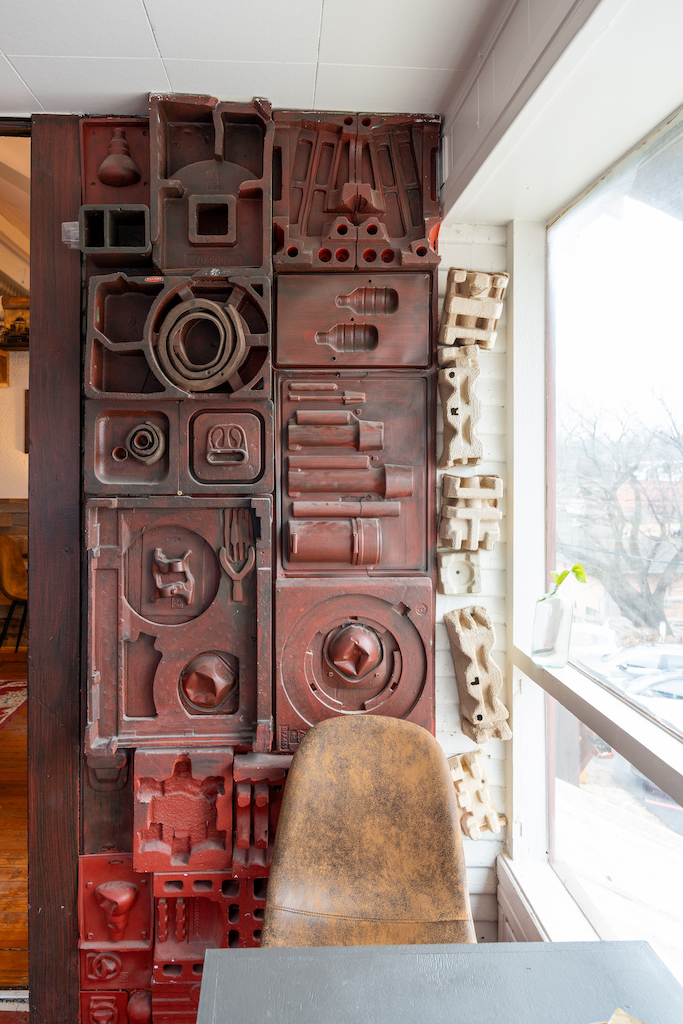
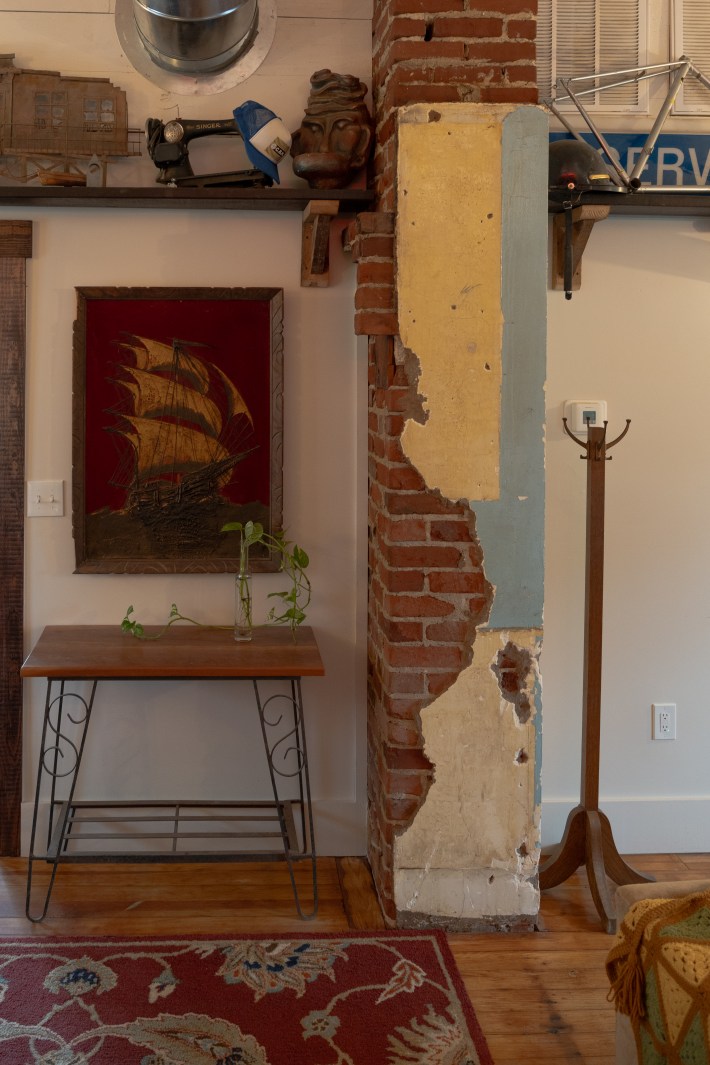
“So much of [Herron’s] fingerprint was here, not just through his photography, but everything,” Gibson says. “Like this collage he did that’s right next to that window. That whole wall is a sculpture that was already there. When we were taking pictures [before the build], I got real close to that. I was like, what is this? Like, sloppily painted red on some brown? It's just a bunch of random shapes. And I realized: it's packaging from stuff that was getting delivered [to the bike shop] in boxes. He chopped it up and put it back together.” Herron did similar collaging on the facade of his own house (a Donald Honn original), Hood tells me, as well as in the peak above the shop’s front door. “It’s just weird stuff, but it works. It’s not just randomly nailed on there. It's very intentional, how it's put together.”
“The whole idea was layering,” Payne says. “Just keep layering everything, so that the more you look, the more you see.” From the finishes to the curation of the objects to the colors and textures, everything Payne incorporated into the remodel was inspired by the original. “Basically, you’ve just got to draw from the space. I didn't reinvent the wheel. I mean, that purple”—on the upstairs window trim—“was back there already, so we painted all this stuff with purple. He really did this.”
“That’s exactly what we're talking about,” Gibson explains. “There's an order to this chaos. And maybe subliminally, as we're putting these things back together, we're like, yeah, this can work. Because—there it is.”
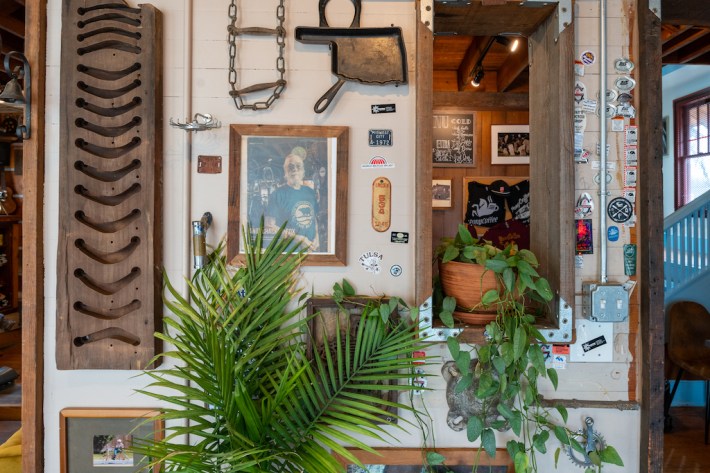
Priority number one, of course, was making the space safe and comfortable, which entailed reframing the roof and adding spray foam insulation, building two bathrooms, and taking down walls upstairs to make the space more open—while taking care to cover what was new in textures that looked organic to the house and could age as well as the original materials. “We wanted to make it look like we didn't touch anything,” Gibson says.
But much of what the team wanted to preserve didn’t exist in any inspector’s handbook, which made the permitting process as weird as the place itself. One example, via Hood: “It's like, well, what's the interior finish classification for this metal panel here that’s 100 years old? Is that Class A, Class B or Class C? There's no manufacturer. I don't know who made that.” You can imagine how many of those moments there were on a project that intentionally chose not to make things new. The actual build took four months, but it took nearly twice as long to get the permits settled.
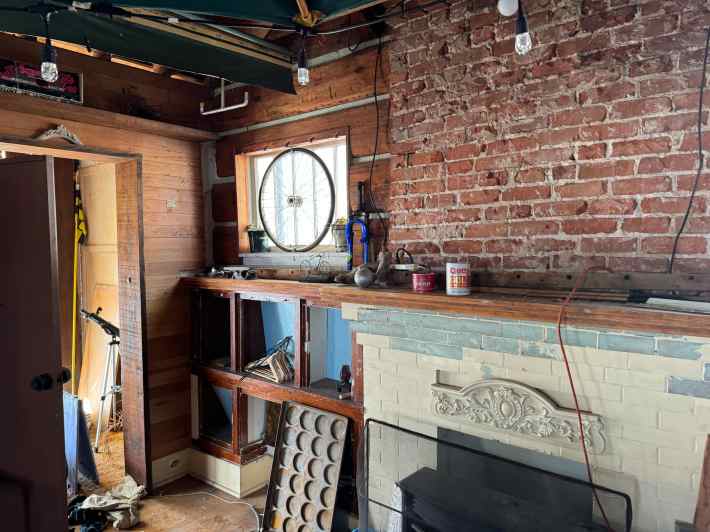
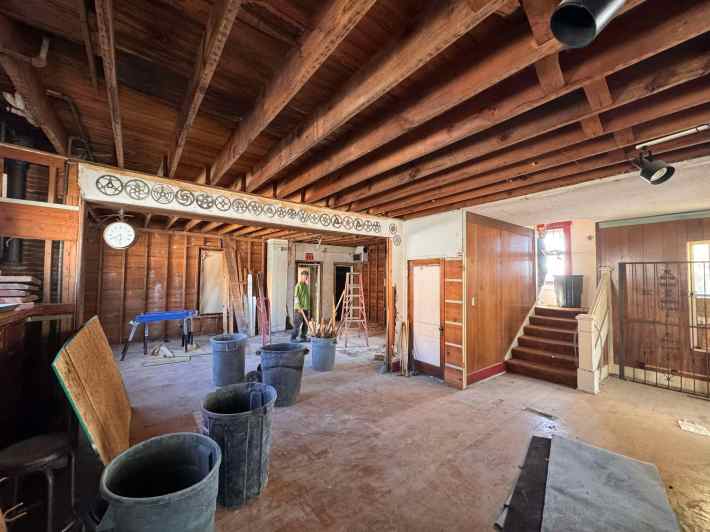
That sort of delay, the team says, is discouraging for developers wanting to do outside-the-box preservation projects like this. Mayors’ offices since time immemorial have promised to “fix permitting.” Actually doing so would make a tangible difference in Tulsa’s urban environment, allowing more creative restoration projects to happen more quickly and cost-effectively, giving us fewer HGTV-style properties and more density, more history, more soul.
The results speak for themselves: this place is a hit, so much so that Pony Coffee is starting its own roastery to produce more whole beans (which have also been unexpectedly popular). The team wonders if a similar concept might work in other parts of Tulsa, with other one-of-one historic sites. “This is a case study in all the right ways to do incremental development in the city,” Hood says.
While a bright, kid-friendly coffee shop seems pretty different from a gritty, sweaty Main Street bar, Pony Coffee and Soundpony share a similar belief: that people want to be in a place that feels personal. “I just want to make sure it's very, very approachable,” Payne says of the new spot. “That's always been our business model for the Soundpony. Everybody's included. Everybody together.”
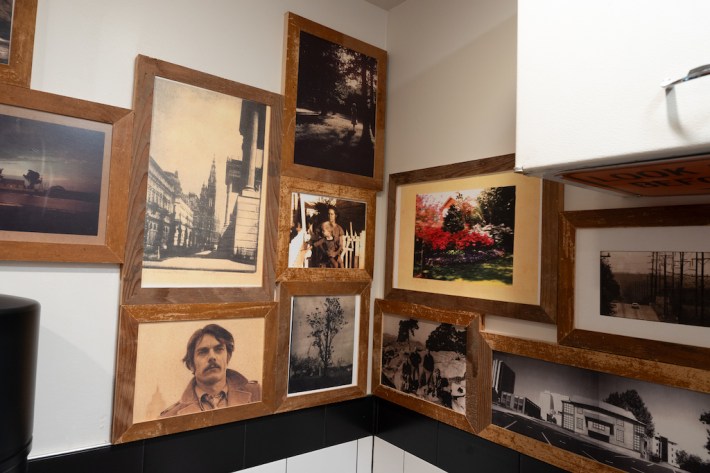
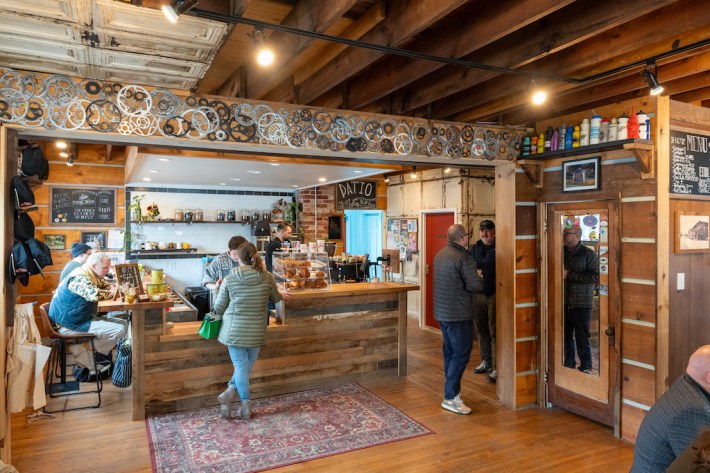
***
Bikes. Photography. Design. Community creativity. Tulsa love. Development. Preservation. Hold up those negatives again: you’ll see them all converging in this house.
When I visited Herron here back in 2017, he pointed me to a page torn from a magazine and pinned to the wall. “Here’s a neat thing from 1973 which I put up because I thought it was so perfect for the state that we’re in,” he said. “Seventy-five cents, Tulsa magazine, which is a Chamber magazine. Here are some shots I did: the serpentine bypass out there that they finally straightened out, the hippie wedding up on top of Reservoir Hill, ‘Stand Up for America’ from 1968 when George Wallace was running for president, the good ol’ boys in front of the gas station with 34-cent-a-gallon gas.
“It says ‘Tulsa was that kind of city’ and that’s why I put it up. I don’t know what Tulsa is now…. We don’t think about how these perfect neighborhoods were done back in the old days and that they should be maintained and not encroached upon. I’m trying to preach that and I’m having a hard time.”
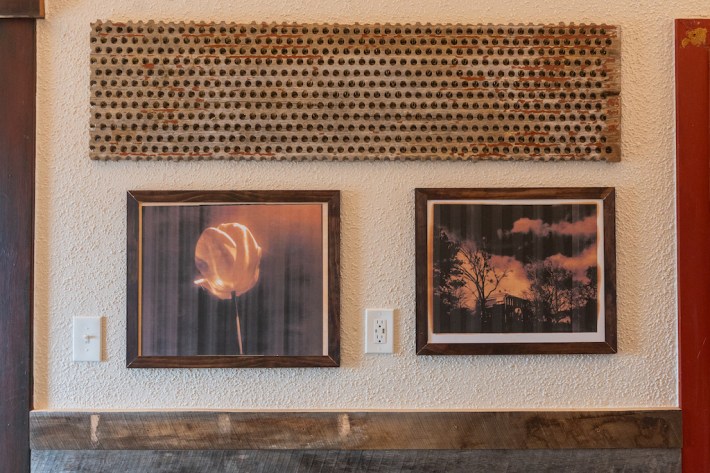
During that conversation, Herron spoke, as he often did, about the influence of Henri Cartier-Bresson’s “decisive moment” on his work—the idea that a photograph hovers time and light and movement off the earth’s surface for a second, suspends them. “Photography started as a record-keeping device, for keeping a visual record of things," he said. "It evolved very slowly and took forever to become an art form itself. In fact they denied until just recently that it was even an art form. It’s not like painting or sculpture, you know. It’s got its own mechanical universe. But it’s not mechanics; it’s more the idea of time.
“Remember that Salvador Dali painting, The Persistence of Memory? He was right on it, what it is. You have to have a before, during, and after. And that’s dictated by the sun and the planets moving around the bodies in the universe. That’s how we have the idea of time.” You capture it, he said, “and then you’re able to go back and review it—and say: this was the moment.”
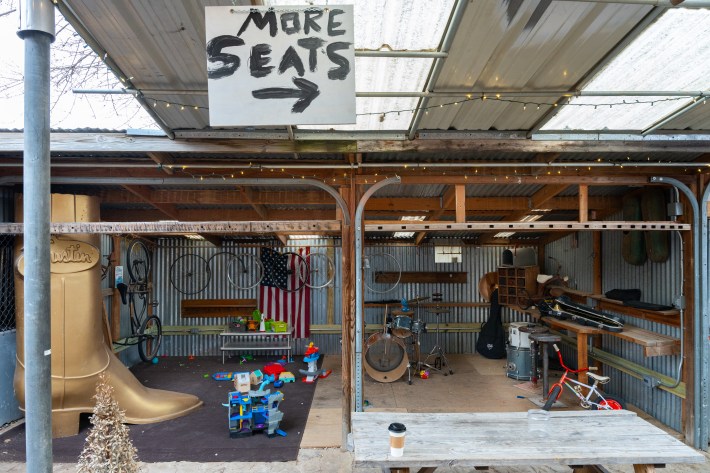
Spare as many of them are, Herron’s images feel so full because, to his eye, they were: full of minor and major histories, the spirits of trees, the invisible ley lines anchoring a space. Many corners in Pony Coffee look like they could have existed in one of Herron’s photographs, like things captured through the window of a moving car—or from the back of a bike. The blur of faces and objects and textures here feels both fresh and familiar, each with its own story.
A house—like a photograph, a city, a person—is the sum of the moments that have filled it. When you walk into this one, you walk into a world.
